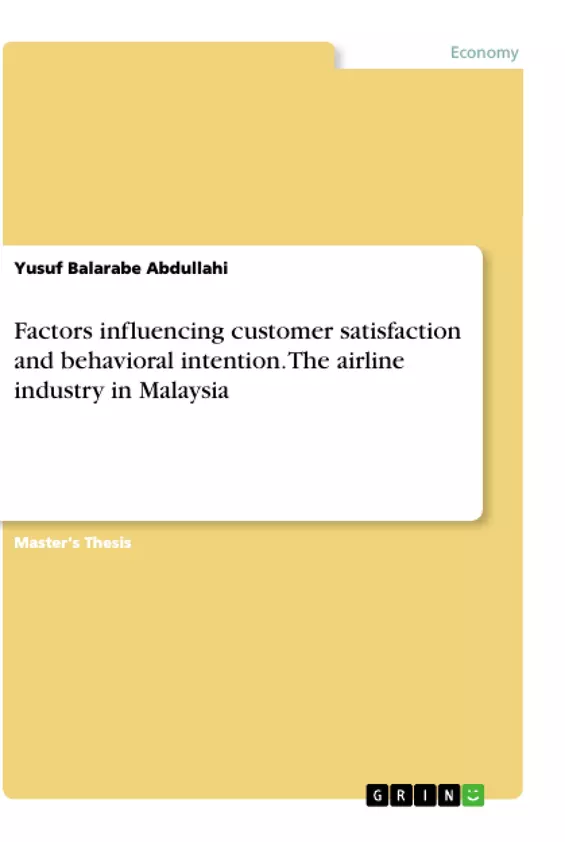The main essential piece of this research would be the factors perceived value, perceived service quality, and brand image as they are the most powerful factors that influence customer satisfaction and Behavioural intentions in airline industry in Malaysia. A change in outlook was recorded as far as the simplicity of transportation and unwavering quality of the airlines companies over the globe. The airline industry has assumed a vital part in the worldwide economy particularly in filling in as an indispensable segment in the tourism industry and stays fundamental to the lead of universal business. The primary worry of any airlines partnership would dependably be satisfying the customers' needs by giving advantages and services at the highest point of its class. Customer satisfaction and Behavioural intentions stay basic in reflecting deals gainfulness and maintainability of the firm.
This makes a consideration for the scientists to explore the key factors that influences the customer satisfaction and Behavioural intentions in airline industry. Consequently, this examination intends to decide the criticalness of contributing factors toward customer satisfaction and Behavioural intentions in minimal effort bearers (Low cost carriers) and full-service transporters in Malaysia. The reason for this investigation was to look at factors that impact the customer satisfaction and Behavioural intentions in airline industry. The information for this investigation was gathered utilizing overview poll. For this examination, the focused on populace is business or potentially relaxation voyagers who have flight encounter either with Low cost carriers or Full service carriers. An example populace of 200 understudies was conveyed to travelers who had no less than one flight involvement with either Low cost carriers or Full service carriers. The information was accumulated from travelers who were sitting tight for their flights in Kuala Lumpur International Airport (KLIA) and Low Cost Carrier Terminal (LCCT). Also, the factual bundle for Social Sciences (SPSS) is being utilized to break down the information gathered all through the study. A couple of proposals are displayed to propose gainful recommendations and call for additionally ponders.
Inhaltsverzeichnis (Table of Contents)
- CHAPTER 1
- 1.0 INTRODUTION
- 1.1 RESEARCH BACKGROUND
- 1.1.1 GLOBAL AIRLINE INDUSTRY
- 1.1.2 Low-Cost Carriers (Low cost carriers) and Full-Service Carriers (Full service carriers)
Zielsetzung und Themenschwerpunkte (Objectives and Key Themes)
This research focuses on investigating the key factors that influence customer satisfaction and behavioral intentions within the airline industry in Malaysia, specifically examining low-cost carriers (LCCs) and full-service carriers (FSCs). The study aims to contribute to a deeper understanding of customer preferences and decision-making processes within this sector, ultimately providing valuable insights for airline organizations.
- Customer satisfaction and its determinants in the airline industry
- Behavioral intentions of airline passengers in Malaysia
- The impact of perceived value, service quality, and brand image on customer satisfaction and loyalty
- Comparative analysis of LCCs and FSCs in Malaysia
- Implications for airline strategy and marketing in the Malaysian context
Zusammenfassung der Kapitel (Chapter Summaries)
Chapter 1 introduces the research by providing background information on the global airline industry, emphasizing the emergence of LCCs and FSCs as distinct models. It highlights the importance of understanding customer satisfaction and behavioral intentions within this context, particularly in the Malaysian market. The chapter outlines the research objectives, questions, and hypotheses, aiming to shed light on the key factors influencing customer satisfaction and behavioral intentions in the airline industry.
Schlüsselwörter (Keywords)
The research focuses on customer satisfaction, behavioral intentions, airline industry, customer loyalty, brand image, low-cost carriers, full-service carriers, Malaysia, and service quality. This study seeks to understand the critical factors driving customer satisfaction and loyalty in the Malaysian airline industry, comparing LCCs and FSCs, and identifying key strategic implications.
- Quote paper
- Yusuf Balarabe Abdullahi (Author), 2019, Factors influencing customer satisfaction and behavioral intention. The airline industry in Malaysia, Munich, GRIN Verlag, https://www.grin.com/document/996394



